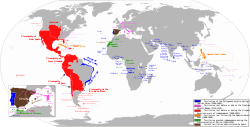
Back Spaanse Ryk Afrikaans الإمبراطورية الإسبانية Arabic الامبراطوريه الاسپانيه ARZ Imperiu Español AST İspaniya imperiyası Azerbaijani ایسپانیا ایمپیراتورلوغو AZB Imperyong Espanyol BCL Іспанская імперыя Byelorussian Испанска империя Bulgarian Impalaeriezh trevadennel Spagn Breton
This article includes a list of references or other websites, but its sources remain unclear because it does not have enough inline citations. |
Spanish Empire Imperio Español | |||||||||
|---|---|---|---|---|---|---|---|---|---|
| 1492–1899 | |||||||||
|
Cross of Burgundy Flag | |||||||||
 | |||||||||
| Capital | Toledo (1492-1561) Madrid (from 1561) | ||||||||
| Common languages | Spanish | ||||||||
| Religion | Roman Catholic | ||||||||
| Government | Monarchy | ||||||||
| Monarch | |||||||||
• 1516-1556 | Charles I | ||||||||
• 1886-1902 | Maria Christina of Austria, Regent during the minority of king Alphonse XIII | ||||||||
| House of Habsburg | |||||||||
| House of Bourbon | |||||||||
| History | |||||||||
| 1492 | |||||||||
• Conquest of the Aztec Empire | 1519-1521 | ||||||||
• Conquest of the Inca Empire | 1532–1537 | ||||||||
• Loss of Puerto Rico | 1899 | ||||||||
| Currency | Spanish real, Spanish escudo | ||||||||
| |||||||||
The Spanish Empire, also known as the Hispanic Monarchy or the Catholic Monarchy [1][2][3] was one of the largest empires in history and one of the first global empires in world history.[4]
Soon after the Reconquista, Spain became the biggest global empire. It led European exploration of the New World, building the large Viceroyalties in the New World. Spain also created the first trade routes across the oceans. The Spanish traded goods across the Atlantic Ocean, between Spain and its viceroyalties in the Americas. They also traded across the Pacific Ocean, between Asian-Pacific countries and Mexico throughout the Spanish treasure fleet and Manila sailing ships.
Spanish Conquistadores conquered the Aztec, Inca, and Maya Empires with the help of other native American tribes. They took large areas of land in North America, South America, Asia, Africa, and Oceania. Spain made these regions into Viceroyalties. Spain, especially the Kingdom of Castile, became much more powerful. Through royal marriages, the Spanish monarchs created alliances with other European powers. This allowed the Spanish Empire to gain control of many territories in Europe. With all these territories and colonies, the Spanish Empire became one of the greatest and richest empires in the world.
For a time, the Spanish Empire was a great power in the oceans, with its experienced Navy. Its infantry known as Tercios, recruited from many countries under the rule of the Spanish monarchy, was undefeated for a century and a half. Spain enjoyed a cultural golden age in the 16th and 17th centuries. The French, Portuguese, and British tried to weaken the Spanish monarchy. Starting in the second half of the 17th century, the Spanish Empire began to suffer bankruptcies, and its military began to lose battles. In the 19th century, Spain lost its last major territories overseas in the Spanish-American War.
- ↑ Fernández Álvarez, Manuel (1979). España y los españoles en los tiempos modernos (in Spanish). University of Salamanca. p. 128.
- ↑ Schneider, Reinhold, 'El Rey de Dios', Belacqva (2002)
- ↑ Hugh Thomas, 'World Without End: The Global Empire of Philip II', Penguin; 1st edition (2015)
- ↑ Thomas, Hugh (August 11, 2015). World Without End: Spain, Philip II, and the First Global Empire. Random House. pp. 496 pages. ISBN 978-0812998115.

